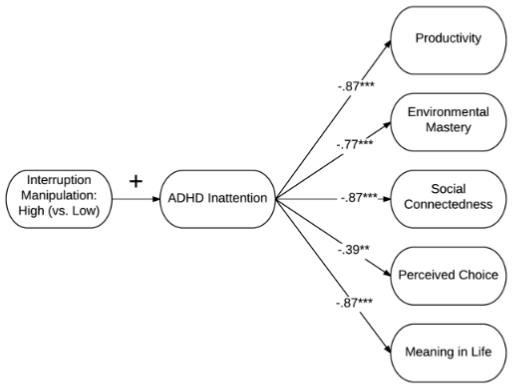Your smartphone and tablet may be making you ADHD-like
May 10, 2016

(credit: KurzweilAI)
Smartphones and other digital technology may be causing ADHD-like symptoms, according to an open-access study published in the proceedings of ACM CHI ’16, the Human-Computer Interaction conference of the Association for Computing Machinery, ongoing in San Jose.
In a two-week experimental study, University of Virginia and University of British Columbia researchers showed that when students kept their phones on ring or vibrate and with notification alerts on, they reported more symptoms of inattention and hyperactivity than when they kept their phones on silent.
The results suggest that even people who have not been diagnosed with ADHD may experience some of the disorder’s symptoms, including distraction, fidgeting, having trouble sitting still, difficulty doing quiet tasks and activities, restlessness, and difficulty focusing and getting bored easily when trying to focus, the researchers said.
“We found the first experimental evidence that smartphone interruptions can cause greater inattention and hyperactivity — symptoms of attention deficit hyperactivity disorder — even in people drawn from a nonclinical population,”said Kostadin Kushlev, a psychology research scientist at the University of Virginia who led the study with colleagues at the University of British Columbia.
In the study, 221 students at the University of British Columbia drawn from the general student population were assigned for one week to maximize phone interruptions by keeping notification alerts on, and their phones within easy reach.

Indirect effects of manipulating smartphone interruptions on psychological well-being via inattention symptoms. Numbers are unstandardized regression coefficients. (credit: Kostadin Kushlev et al./CHI 2016)
During another week participants were assigned to minimize phone interruptions by keeping alerts off and their phones away.
At the end of each week, participants completed questionnaires assessing inattention and hyperactivity. Unsurprisingly, the results showed that the participants experienced significantly higher levels of inattention and hyperactivity when alerts were turned on.
Digital mobile users focus more on concrete details than the big picture
Using digital platforms such as tablets and laptops for reading may also make you more inclined to focus on concrete details rather than interpreting information more contemplatively or abstractly (seeing the big picture), according to another open-access study published in ACM CHI ’16 proceedings.
Researchers at Dartmouth’s Tiltfactor lab and the Human-Computer Interaction Institute at Carnegie Mellon University conducted four studies with a total of 300 participants. Participants were tested by reading a short story and a table of information about fictitious Japanese car models.
The studies revealed that individuals who completed the same information processing task on a digital mobile device (a tablet or laptop computer) versus a non-digital platform (a physical printout) exhibited a lower level of “construal” (abstract) thinking. However, the researchers also found that engaging the subjects in a more abstract mindset prior to an information processing task on a digital platform appeared to help facilitate a better performance on tasks that require abstract thinking.
Coping with digital overload
Given the widespread acceptance of digital devices, as evidenced by millions of apps, ubiquitous smartphones, and the distribution of iPads in schools, surprisingly few studies exist about how digital tools affect us, the researchers noted.
“The ever-increasing demands of multitasking, divided attention, and information overload that individuals encounter in their use of digital technologies may cause them to ‘retreat’ to the less cognitively demanding lower end of the concrete-abstract continuum,” according to the authors. They also say the new research suggests that “this tendency may be so well-ingrained that it generalizes to contexts in which those resource demands are not immediately present.”
Their recommendation for human-computer interaction designers and researchers: “Consider strategies for encouraging users to see the ‘forest’ as well as the ‘trees’ when interacting with digital platforms.”
Jony Ive, are you listening?
Abstract of “Silence your phones”: Smartphone notifications increase inattention and hyperactivity symptoms
As smartphones increasingly pervade our daily lives, people are ever more interrupted by alerts and notifications. Using both correlational and experimental methods, we explored whether such interruptions might be causing inattention and hyperactivity-symptoms associated with Attention Deficit Hyperactivity Disorder (ADHD) even in people not clinically diagnosed with ADHD. We recruited a sample of 221 participants from the general population. For one week, participants were assigned to maximize phone interruptions by keeping notification alerts on and their phones within their reach/sight. During another week, participants were assigned to minimize phone interruptions by keeping alerts off and their phones away. Participants reported higher levels of inattention and hyperactivity when alerts were on than when alerts were off. Higher levels of inattention in turn predicted lower productivity and psychological well-being. These findings highlight some of the costs of ubiquitous connectivity and suggest how people can reduce these costs simply by adjusting existing phone settings.
Abstract of High-Low Split: Divergent Cognitive Construal Levels Triggered by Digital and Non-digital Platforms
The present research investigated whether digital and non-digital platforms activate differing default levels of cognitive construal. Two initial randomized experiments revealed that individuals who completed the same information processing task on a digital mobile device (a tablet or laptop computer) versus a non-digital platform (a physical print-out) exhibited a lower level of construal, one prioritizing immediate, concrete details over abstract, decontextualized interpretations. This pattern emerged both in digital platform participants’ greater preference for concrete versus abstract descriptions of behaviors as well as superior performance on detail-focused items (and inferior performance on inference-focused items) on a reading comprehension assessment. A pair of final studies found that the likelihood of correctly solving a problem-solving task requiring higher-level “gist” processing was: (1) higher for participants who processed the information for task on a non-digital versus digital platform and (2) heightened for digital platform participants who had first completed an activity activating an abstract mindset, compared to (equivalent) performance levels exhibited by participants who had either completed no prior activity or completed an activity activating a concrete mindset.

(credit: KurzweilAI/Apple)